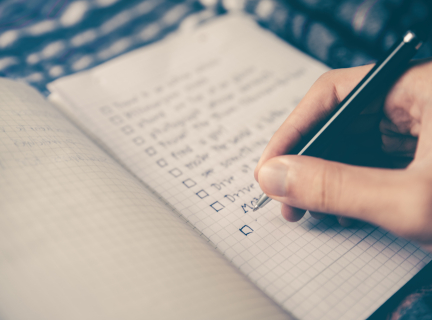Planning Your Podcast

Before you press the record button, there are a couple final steps to prepare for your podcast.
- Format: The structure of your podcast
- Content: What’s your podcast going to say?
Format
Given the newer nature of this medium, new styles of podcasting are always being created and the format being re-imagined. Podcasts can have many different formats but the following are the most popular.
Types of podcasts:
- The Interview Show: Most popular format. Has a host and a guest with pre-determined questions and room left for improvisation.
- The solo podcast: One person speaking into a mic. Easiest to do.
- The panel show: A host and guest(s) discuss a topic and weigh in.
- Educational: A host and guest who is an expert on that particular topic with research done beforehand for informed discussion of topic.
- Non-fiction storytelling: Usually done with a team and often containing a lot of audio elements including grabs of interviews, ambient sound, phone conversations, etc.
- Fiction storytelling (sometimes called podcast theatre or podcast novel): For writers, this style is often more audio cinema than audio book and often requires music, a higher level of production and potentially a voice-over artist.
Make sure you decide which format you want and whether or not you want to have guests in the planning stages.
Keep in mind an important consideration when making these decisions is WHO this podcast is for? Identify who your ideal or target audience is for this podcast and consider them when planning out your podcast.
Other considerations:
- Title
- Description
- Length of episodes
- How often are you going to release an episode?
- Guests?
- Rating
Podcast Description
Podcast description should be between 300-500 words and include as many relevant keywords as possible for search engine optimization (makes your podcast more searchable).
Make sure to include the following in the description:
- Who are you and what do you do?
- What is your mission?
Your description should let listeners know what you are going to do or what you are going to include in your show.
Podcast Script Template
A podcast script is a skeleton of your episode that you can customize. Every podcast, even the most improvised-sounding ones, have some working template or outline they use to maintain consistency across episodes and which allows the host(s) to concentrate on the content.
An example of a working template have the following elements:
- Show intro (who you are and what you’re going to talk about): 30-60 seconds
- Intro music (repeat for each show so listeners identify the jingle with your show): 30-60 seconds
- Topic 1: 3 minutes
- Topic 2: 3 minutes
- Interlude (music or break): 30 seconds
- Topic 3: 3 minutes
- Topic 4: 3 minutes
- Closing remarks (thank audience, thank guests, talk about the next show): 2 minutes
- Closing music (suggest same as Intro music jingle): 2 minutes
A good way to decide what template you want to adopt for your own podcast is to consider your format and then listen to similar podcasts that you enjoy and listen for their template.
It's a good idea to choose a podcast script style before launching your first episode.
Podcast Artwork
You will need to design artwork for your podcast which is a visual representation of your podcast that will appeal to your target audience.
- Keep in mind, your podcast cover is the first thing your listeners will see when they search for it on their phones.
- Apple requires at least a 1,400 by 1,400 pixel JPG or PNG image for Apple podcasts in the RGB colorspace.
- To optimize images for mobile devices, Apple recommends compressing your image files.
You can visit our free media sources page for some free images.
Free design apps:
Canva (https://www.canva.com/)
Snappa (https://snappa.com/)
Stencil (https://getstencil.com/)
Desygner (https://desygner.com/)
Adobe Creative Cloud Express (https://www.adobe.com/express/)
Music, Sound Effects and Other Audio
Most podcasts have an intro and outro song played at the start and end of the podcast. This theme music should match the tone and feel of your podcast. You can create your own music, use royalty-free music or commission a friend to create a jingle or song.
Keep in mind you cannot use copyrighted music or material in your podcast.
Including music and sounds helps you establish an atmosphere and tone.
- Some ways music and sound effects may fit into your podcast:
- Intros and outros: theme music or jingle
- To reinforce dramatic or comedic moments
- To help establish a sense of place in a story
- To segue between segments or introduce a guest
- As a key talking point in your show
- As background filler
- DO NOT use copyrighted music or sounds that you are not licensed to use.
Media you can use include:
- Public domain work (copyright has expired OR artist has dedicated their work to the public domain)
- Creative commons material: an open licensing standard that allows creators of content to share their work under clear and transparent terms.
- You can always create your own music (or commission a friend)
Podsafe Audio Media Sources:
Free audio media sources:
- Creative Commons: Free Music Archive
- Free Sound: Public domain sound effects
- Community Audio: Public domain music and spoken word
- Wikimedia Commons: Images, sound, and video available for free reuse
